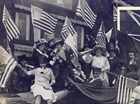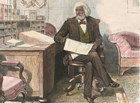Series by Megan Bailey. The right to vote (also known as suffrage) is an important part of our democracy. Throughout history, different groups were prevented from taking part in the voting process. At one point, women, people of color, and immigrants could not vote. People without money, property, or an education were also barred from voting. Discover the relationship between the 15th and the 19th Amendments that guaranteed access to the ballot.
-
Article 1: Civil Rights: Whose Voice is Heard?

Have you ever wanted your voice to be heard? Discover the power of the vote! Voting is a way for us to express our opinions and choices. It is an opportunity for Americans to choose our leaders and have a say in important issues that affect our communities. The right to vote (also called suffrage or enfranchisement) means that Americans have the right to be heard. Read more
-
Article 2: The Fifteenth Amendment

The Fifteenth Amendment was adopted in 1870, recognizing the suffrage rights of African American men. Black men began voting in local, state, and national elections, and ran for political office. However, in the 1890s many Southern states passed laws that made it more difficult for African Americans to vote. Read more
-
Article 3: The Nineteenth Amendment

During the United States’ early history, women were denied many of the rights enjoyed by men and faced discrimination because of their sex. Women were excluded from many jobs and educational opportunities. But because they did not have the right to vote (also known as suffrage), women were limited in terms of how much influence they could have over laws and policies Read more
-
Article 4: Between Two Worlds: Black Women and the Fight for Voting Rights

During the 19th and 20th centuries, Black women played an active role in the struggle for universal suffrage. They participated in political meetings and organized political societies. African American women attended political conventions at their local churches where they planned strategies to gain the right to vote. Read more
-
Article 5: Fighting for Suffrage: Comrades in Conflict
Even when people are working toward common goals, they may disagree on the best way to achieve those goals. One case from the struggle for voting rights involved a split between the abolitionist Frederick Douglass and the women’s rights pioneers Susan B. Anthony and Elizabeth Cady Stanton. For years, the three activists were close friends and worked side-by-side to pursue universal suffrage (the right to vote for all adult citizens) and the abolition of slavery. Read more
-
Article 6: Voting Rights: Celebrations of Success

The ratifications of the Fifteenth and Nineteenth Amendments, fifty years apart, were exciting times for many people. Throughout the long struggle for voting rights, people devoted time, energy, and resources to making society better for everyone. Read more
-
Article 7: Voting Rights: What’s Next?

A century ago, people who demanded universal suffrage were considered idealistic, strange, or even dangerous. Now we take these ideas for granted as essential to American democracy. The dreams of previous generations have become the common sense of today. Read more

